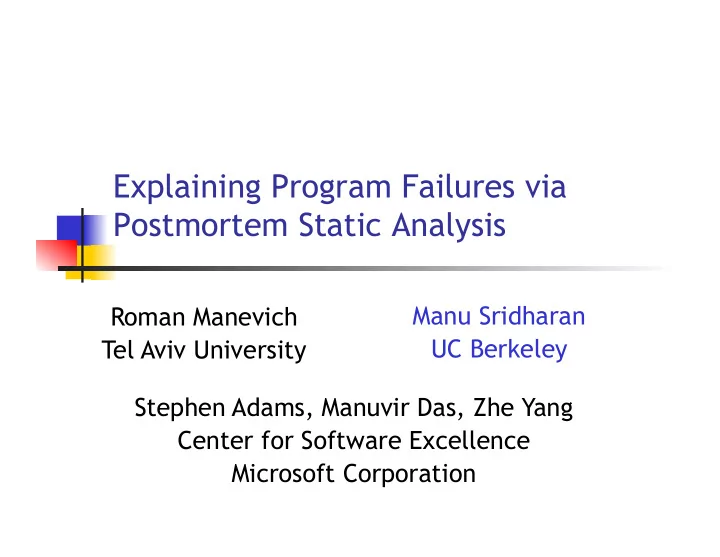

Explaining Program Failures via Postmortem Static Analysis Manu Sridharan Roman Manevich UC Berkeley Tel Aviv University Stephen Adams, Manuvir Das, Zhe Yang Center for Software Excellence Microsoft Corporation
Motivation • Programs are shipped with bugs • Crash reports ease bug fixing • Automated, sent over network • Give type of failure and stack trace • But, problems remain • No execution trace provided • Reconstructing trace is time-consuming
An Example Crash foo(rec *x, rec *z) { Does dereference of z matter? q = z->f; What does p point to? *p = u; if (b) Lots to keep track of! y = z; Which branch? Both? else y = x->f; *y = …; NULL pointer dereference }
Tool Support Needed • Input: crash report • Program point of failure • Type of failure, eg. NULL dereference • Output: error traces • Paths to point of failure that cause error
Static slicing? foo(rec *x, rec *z) x->f NULL at entry { q = z->f; *p = u; more informative if (b) infeasible y = z; error-specific else slice y = x->f; *y = …; static slice }
P ostmortem S ymbolic E valuation • Dataflow analysis to find traces • Track value backwards from error • Maintain flow information on each path • Use error type to filter traces • Borrow techniques from ESP [DLS02] • For scalability, precision, soundness
Tracking Flow: The Witness Expressions holding value {} witness u->f = NULL; {u->f} z = u; {u->f,z->f} y = z; {u->f,z->f,y->f} x = y->f; {u->f,z->f,y->f,x} *x = …; • Expression from which value is copied • Specific to path • Single witness per point on path • Demand analysis
Computing The Witness Witness Witness u->f = NULL; done <z->f> *p = u; <u->f> <?> <?> <z->f> y = z; <z->f> <z->f> <y->f> <y->f> x = y->f; <x> <x> *x = …; p == &z p != &z • Substitution like weakest preconditions • Query aliasing oracle for indirect updates • Still polynomial time • Bound number of witnesses • Switch to abstract location when too long
Using The Error Type • No double deref of NULL on path • x = NULL; *x = y; *x = z is infeasible • Just check if witness is dereferenced • In general, handle typestate errors • Automaton describes behavior • Crash at transition to error state • Do double derefs generalize?
Automaton Reversal Closed Print/Close File I/O Error Open Close Open Opened Print reverse Closed Print/Close ? print(f,”hi”); Error close(f); Open Close Open infeasible Opened Print
Putting It All Together • ESP-style dataflow analysis [DLS02] • Interprocedural, path-sensitive • Engine maintains / presents traces • GOLF serves as aliasing oracle [DLFR01] • Stack trace used if available • Restricts traversal up call stack • Detect simple tests for NULL • Eg. if (p) • If p is witness on true branch, infeasible
Evaluation: Does It Scale? • Test SPEC95 derefs for NULL deref • 2,000 – 140,000 lines of code • 100 random derefs per benchmark • If no traces for a deref, proven safe • No stack traces • Configurations • Normal: full analysis • NoDD: no filtering using double derefs
Average Query Times • Most queries fast (usually more than 90%) • The rest are quite slow (minutes) • No useful analysis result, so timeout (15 seconds)
Aliasing • Imprecise analysis for heap pointers • False positives + increased analysis time • Traces with aliasing inscrutable • No explanation for alias • Thus far, useless to developers • Configuration “Unsound” • No checking for indirect updates • No abstraction for long witnesses
SPEC Number of Error Reports • Remaining false positives • Global flag • Use of abstract locs (eg. a[i])
Evaluation: Useful traces? • PREfix: static bug finding tool [BPS00] • Checked five real NULL deref errors • Five successes with “Unsound” • Found error-causing traces only • Query times under a second • Stack traces helpful • Four succeeded with “Normal”
Related Work • Slicing [Tip95] • Postmortem analysis [LA02] • Typestate analysis [SY86,SY93] • Fault localization • Remote program sampling [LAZJ03] • Forward analyses (Metal, ESP, model checkers)
Conclusions • New analysis for diagnosing errors • Value traced back from error • Witnesses give useful flow information • False traces pruned using error type • Results are promising • Extensions • Integration with Watson • Evaluating other typestate errors • Presentation of aliases to developer
The End
Recommend
More recommend